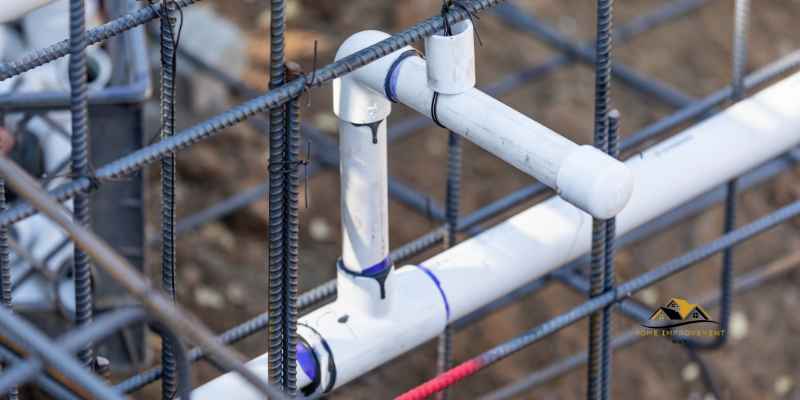To remove markings and barcodes from PVC pipes, saturate a cloth with acetone and rub the pipe until clean. Repeat until the markings are completely removed.
When working with PVC pipes, it’s common to encounter markings and barcodes that need to be removed for aesthetic or functional reasons. Whether you’re building a backdrop or working on a DIY project, it’s important to have clean and unmarked pipes.
We will discuss an effective method for removing markings and barcodes from PVC pipes using acetone. By following these simple steps, you can achieve a professional and polished look for your PVC pipe project. Let’s dive into the details of how to successfully remove markings and barcodes from PVC pipes.
Common Methods
When it comes to removing markings, writing, and bar codes from PVC pipes, there are several common methods that can be employed to achieve a clean and professional finish. These methods include using acetone and mechanical removal with steel wool. Each method has its own advantages and considerations, so it’s essential to understand the best approach for your specific needs.
Using Acetone
One effective method for removing markings and bar codes from PVC pipes is by using acetone. Acetone is a powerful solvent that can effectively dissolve and remove ink, paint, and other markings from the surface of PVC pipes.
To use acetone for this purpose, saturate a part of a cloth with acetone, which can be found in standard nail polish remover, and then gently rub the marked PVC pipe or fitting to remove the print and dirt. Repeat the process until the surface is clean. It’s important to note that this process actually removes the outer layer of PVC from the pipe, so it should be used with caution to avoid damaging the pipe.
Mechanical Removal With Steel Wool
Another common method for removing markings and bar codes from PVC pipes is through mechanical removal using steel wool. This method involves using fine-grade steel wool to gently scrub the surface of the PVC pipe, effectively removing the markings and bar codes. It’s important to use a gentle touch to avoid scratching or damaging the surface of the pipe. Additionally, it’s essential to ensure that the steel wool is free from any debris or particles that could cause further damage to the PVC pipe.
Step-by-step Guide
Easily remove markings and bar codes from PVC pipes by saturating a cloth with acetone. Gently rub the affected area until clean, repeating the process as needed for a pristine finish. This simple step-by-step guide ensures a smooth removal process without damaging the pipe’s integrity.
Preparing The Surface
Before removing markings and bar codes from PVC pipes, ensure the surface is clean and dry.
- Wipe the PVC pipe with a clean cloth to remove any dust or debris.
- Inspect the pipe for any stubborn markings that may require extra attention.
Application Of Acetone
Acetone is an effective solvent for removing markings from PVC pipes.
- Saturate a cloth with acetone, which can be found in standard nail polish remover.
- Rub the marked areas on the PVC pipe with the acetone-soaked cloth in a circular motion.
- Repeat the process until the markings are completely removed.
Mechanical Removal Process
If the markings are stubborn, a mechanical removal process can be used.
| Materials Needed: | Scrubbing pad or abrasive sponge | Scraping tool |
|---|---|---|
| Steps: | Gently scrub the marked areas with a scrubbing pad or abrasive sponge. | Use a scraping tool to carefully scrape off any remaining markings. |
Safety Precautions
Removing markings, writing, and barcodes from PVC pipes can be done by using acetone. Saturate a part of the cloth with acetone and rub the marked up PVC pipe or fitting to remove the print and dirt. Repeat until clean.
However, it is important to be careful as this process removes the outer layer of PVC from the pipe.
Ventilation
Ensure to work in a well-ventilated area when removing markings and bar codes from PVC pipes. Proper ventilation helps in minimizing exposure to fumes and chemicals.
Protective Gear
Wear appropriate protective gear such as gloves and safety goggles to protect your skin and eyes from any potential chemical splashes during the marking removal process.
Alternative Solutions
Denatured Alcohol
Denatured alcohol is an effective alternative solution for removing markings, writings, and bar codes from PVC pipes. It is a versatile solvent that can dissolve a wide range of substances, making it suitable for cleaning and preparing PVC surfaces. When using denatured alcohol, it is important to apply it in a well-ventilated area and use appropriate protective gear, such as gloves and goggles, due to its strong fumes and flammability. Additionally, denatured alcohol should be handled with care and stored in a safe place away from children and pets.
Other Solvents
Aside from denatured alcohol, there are other solvents that can be utilized to remove markings and bar codes from PVC pipes. These include acetone, nail polish remover, and isopropyl alcohol, which are commonly found in household or industrial settings. It is essential to consider the compatibility of the solvent with PVC material to avoid any potential damage. Prior to applying any alternative solvent, it is advisable to conduct a spot test on a small, inconspicuous area of the PVC pipe to ensure it does not cause adverse effects such as discoloration or degradation.
Community Recommendations

When it comes to removing markings, writing, and barcodes from PVC pipes, the community has shared valuable insights and experiences. Whether it’s through user experiences or expert advice, the collective knowledge of the community offers practical solutions and tips for effectively addressing this issue.
User Experiences
Several users have shared their successful methods for removing markings and barcodes from PVC pipes. Some have recommended using acetone-soaked cloths to gently rub the marked areas, while others have suggested using specialized PVC cleaning solutions. These firsthand experiences provide valuable guidance for individuals seeking effective ways to clean PVC pipes.
Expert Advice
Experts in the field have emphasized the importance of using acetone or nail polish remover to effectively remove markings and barcodes from PVC pipes. They have highlighted the need for caution when applying these substances and have recommended using a gentle, circular motion to ensure thorough cleaning without damaging the PVC material. Additionally, experts have suggested using appropriate safety measures, such as wearing gloves and working in a well-ventilated area, when using chemical solutions for cleaning PVC pipes.
Practical Applications
Removing markings, writing, and barcodes from PVC pipes serves various practical applications, making it an essential process in different industries and DIY projects. This technique finds application in backdrop construction, DIY projects, and more. Read on to explore the diverse practical applications of removing markings and barcodes from PVC pipes.
Backdrop Construction
Backdrop construction often involves the use of PVC pipes to create versatile and lightweight structures. By removing markings and barcodes from PVC pipes, construction professionals can ensure a clean and professional appearance for their backdrops. This is particularly crucial for events, stage performances, and photography, where the aesthetics of the backdrop play a significant role in creating the desired ambiance.
DIY Projects
For DIY enthusiasts and hobbyists, PVC pipes are a popular choice for various projects such as furniture making, gardening, and home improvement. By removing the markings and barcodes, individuals can achieve a polished and seamless look in their creations. Whether it’s crafting custom shelving units or constructing planters, clean PVC pipes without any visible markings enhance the overall aesthetic appeal of the final product.

Frequently Asked Questions
How To Get Rid Of Writing On Pvc Pipe?
To remove writing on PVC pipe, use acetone on a cloth to wipe off markings and bar codes effectively.
How To Remove Barcode From Pvc Trim?
To remove a barcode from PVC trim, use acetone-soaked cloth to rub the marked area until the print is removed.
What Does The Writing On Pvc Pipe Mean?
The writing on PVC pipe usually indicates the size of the pipe, which can be printed in fractional or decimal format, along with other specifications. Acetone can be used to remove markings and bar codes from PVC pipe by rubbing the affected area with a cloth saturated with acetone until clean.
However, this process removes the outer layer of PVC from the pipe. It is recommended to use denatured alcohol instead of acetone to prevent etching of the PVC.
Can You Use Acetone On Pvc?
Yes, you can use acetone on PVC to remove markings and bar codes effectively. Rub the acetone-soaked cloth on the PVC surface to clean it.
Conclusion
Removing markings, writings, and barcodes from PVC pipes is a simple process that can be done easily with the help of acetone and a cloth. The markings on PVC pipes can be confusing and may not fit your desired look, but with the use of the right method, you can easily get rid of them.
By following the steps outlined you can clean your PVC pipes and fittings to give them a new look. Removing markings from PVC pipes can be a quick and easy DIY project that will leave you with a professional-looking result.


